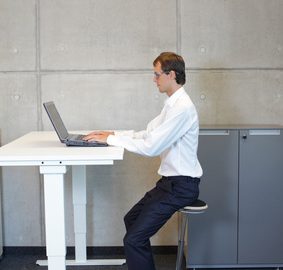Are you using your laptop safely?
More people are working remotely and travelling. Desk spaces are often shared, or used on the fly, like a coffee shop. More people are using laptops for this reason. The use of laptops is even a personal convenience choice. Gone are the days of a pen and paper and writing notes out in college. Most students use a laptop bringing it from class to class.
With the convenience of a laptop, there is a trade-off with body positioning. When the screen is at an optimal height, the keyboard is too high. When the keyboard is at an optimal position, the screen is too low. There will be a trade-off between poor head and neck positioning and shoulder/wrist positioning.
For short term use it may not cause a problem, but even repetitive short term use in an awkward position may lead to problems.
Laptop Tips from an Oakville Physiotherapist:
These tips are dependent on the required use of the laptop. If you are typing briefly versus using it as a consistent workstation.
Long Term Use (>1 hour):
- At a minimum try and place the laptop on a surface that allows your shoulders, wrists, and elbows to stay in relaxed and neutral positions.
- Have the screen tilted to the line of sight.
- Use a laptop stand / rise and a wireless keyboard. This allows for the separation while still having the convenience of a laptop.
Short Term Use (<1 hour):
- Sit in a comfortable chair that supports your back.
- Try to position the laptop at a height so your wrists and elbow are neutral. Avoid surfaces that cause you to shrug your shoulders up. If this is the case consider standing at a counter of suitable height.
- If you are sitting without a table our counter, try a lap tray to raise the laptop up slightly.
- Tilt the screen away slightly. Avoid allowing your head to fall forward.
As with any repetitive or stationary work, our Physio’s, Yoga Therapists, and Massage Therapists suggest taking small breaks throughout the workday. They don’t have to be complicated or time consuming. Your Physio or Massage Therapist can help provide you individual guidance in this capacity, to help make these breaks the most beneficial and efficient.


